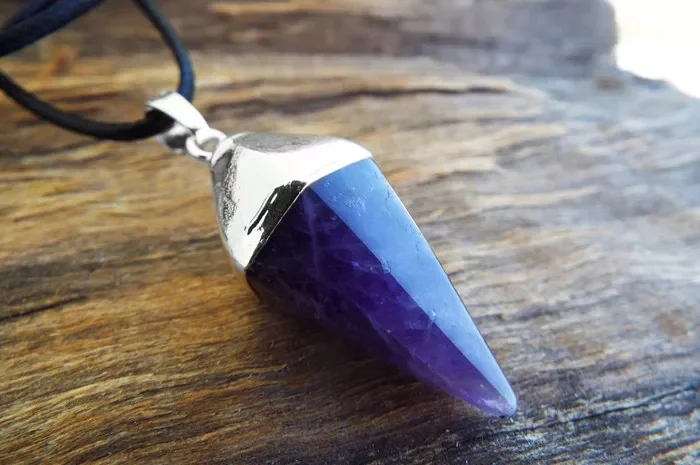Amethyst, a popular and cherished variety of quartz, is renowned for its stunning purple hues and is often used in jewelry and decorative pieces. However, many amethyst owners have encountered a perplexing issue: the appearance of black dots or specks within their crystals. While these inclusions may seem unsightly at first glance, they are actually a fascinating part of the amethyst’s geological history and can even add to the stone’s beauty and value in certain cases. In this article, we’ll explore what causes these black inclusions, how they form, and whether they impact the quality and desirability of amethyst specimens.
What Are the Black Inclusions in Amethyst?
The black inclusions in amethyst are typically composed of manganese oxide minerals like pyrolusite (MnO2) or psilomelane (BaMn8O16(OH)4). These minerals are deposited in the cavities and fractures of the amethyst as it grows, creating a distinctive black color.
The black color comes from the oxidation state of the manganese ions. In pyrolusite, the manganese is in the +4 oxidation state, while in psilomelane it is a mix of +4 and +2. This difference in oxidation state can cause slight variations in the black color, from bluish to brownish black.
How Do the Black Inclusions Form?
Amethyst forms when silica-rich hydrothermal fluids fill gas cavities or fractures in igneous or metamorphic rocks. As the fluids cool and the pressure decreases, the silica precipitates out, forming quartz crystals. In the case of amethyst, the quartz crystals take on a purple color due to the presence of trace amounts of iron.
The black manganese oxide inclusions form in a similar way, but at a later stage in the amethyst’s growth. As the hydrothermal fluids continue to circulate through the rock, they pick up manganese ions from the surrounding rock. When these manganese-rich fluids encounter the already-formed amethyst crystals, the manganese precipitates out, forming the black inclusions.
The specific conditions that lead to the formation of the black inclusions are not fully understood, but it likely involves a change in the chemistry or temperature of the hydrothermal fluids. The inclusions can form at any stage during the amethyst’s growth, resulting in a variety of patterns and distributions within the crystal.
See Also: Where Do You Put an Amethyst Pyramid?
Types of Black Inclusions in Amethyst
There are several different types of black inclusions that can occur in amethyst, each with its own distinctive appearance:
Dots or Chunks: These are the most common type of inclusion, appearing as small, discrete black spots or larger, irregularly shaped chunks within the amethyst crystal.
Bands or Layers: In some cases, the black inclusions form in distinct bands or layers, creating a banded or layered pattern within the amethyst.
Dendritic or Moss-like: Occasionally, the black inclusions take on a more intricate, tree-like or moss-like appearance, creating striking patterns within the amethyst.
Oriented Inclusions: In rare cases, the black inclusions align themselves in a specific orientation within the amethyst crystal, often following the crystal’s growth planes or fractures.
The type and distribution of the black inclusions can vary widely, even within a single amethyst cluster. This diversity adds to the uniqueness and visual appeal of each specimen.
Impact on Amethyst Quality and Value
The presence of black inclusions in amethyst is generally not considered a defect or a negative factor in terms of quality. In fact, many collectors and enthusiasts find the inclusions to be an interesting and attractive feature of the stone.
However, the impact of the inclusions on the amethyst’s value can vary depending on several factors:
Size and Distribution: Larger, more prominent inclusions that dominate the amethyst’s appearance may be less desirable to some collectors, especially if they are unevenly distributed.
Clarity: Amethyst with very dense or opaque inclusions that significantly reduce the stone’s transparency may be less valuable than clearer specimens.
Rarity and Uniqueness: Amethyst with unusual or striking inclusion patterns, such as oriented inclusions or dendritic inclusions, can be highly sought after by collectors and may command higher prices.
Locality: The origin of the amethyst can also affect its value, with specimens from certain localities, such as Uruguay or Zambia, being more prized by collectors.
In general, the presence of black inclusions in amethyst is not a major detractor from the stone’s value, and many people find them to be an interesting and attractive feature. However, the specific impact on value will depend on the individual collector’s preferences and the overall quality and rarity of the specimen.
Conclusion
Black inclusions in amethyst are a fascinating geological phenomenon that adds to the stone’s unique character and appeal. While the inclusions may seem unsightly at first glance, they are a natural part of the amethyst’s growth process and can even enhance the stone’s value in certain cases.
As an experienced gemologist, I find the study of amethyst inclusions to be a fascinating area of research. By understanding the formation and distribution of these inclusions, we can gain insights into the geological history of the amethyst and appreciate the beauty and complexity of these natural wonders.
Whether you are a collector, a jewelry maker, or simply someone who appreciates the beauty of nature, amethyst with black inclusions is a stunning and intriguing gemstone that is sure to capture your imagination.


